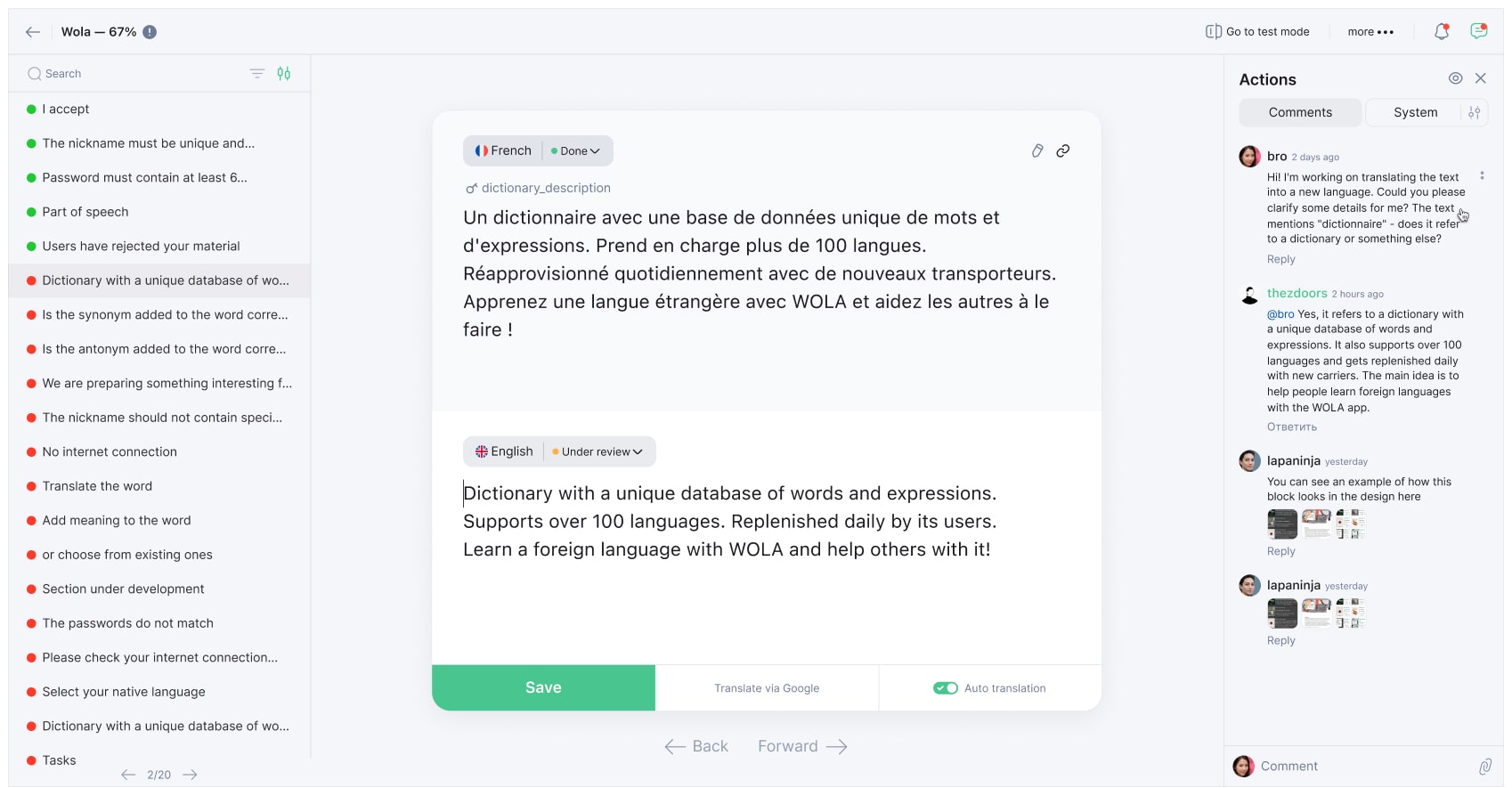Localizing your business to conquer a new market sounds like a great idea until you actually have to sit down and get started. As you go deeper, more and more challenges arise on your way, which demand effective and resolute solutions, from paying special attention to scripts to making sure your visuals make sense in a new region. Let alone, paying special attention to the target language and translations.
Professional translators and native speakers are a great way to address this issue (if you like to spend a lot of money and have a huge amount of time to spare). If you are a business that values cost-efficiency and speed, there is an answer to your demands. The advent of AI and AI tools has left its mark on the market of localization too! This article will explore AI localization, how it works, and how it can benefit your business.
What Is AI Localization?
Simply speaking, it is the same as traditional localization but faster, cheaper and less prone to mistakes. AI localization uses the advances of artificial intelligence to provide more accurate and more specific translations which fit your requirements much better than traditional machine translations.
Modern localization software like Localit uses this breakthrough in AI-powered workflow by, for example, offering translations of your content, keywords, texts, and more with ChatGPT without you needing a separate subscription to the chatbot.
Role of AI in Translation and Localization
Basically, AI is revolutionizing the way we approach localization, just like any other industry it is applied in. But when it comes to translation, here's a short list of advantages of using AI in localization:
Efficiency and Speed: AI accelerates the translation process, enabling faster localization of content.
Cost-Effectiveness: Reduces reliance on costly human translators for high-volume tasks.
Consistency: Ensures uniformity in terminology and style across all translated content.
Cultural Adaptation: AI tools can identify and adjust for cultural nuances in different regions.
Scalability: Handles large-scale localization projects with ease, accommodating growing business needs.
The list is not full, by any means. Arguably the biggest advantage of this technology is that it allows humans to focus on a greater picture rather than mundane details. Here's a quote for you:
“Artificial intelligence and generative AI may be the most important technology of any lifetime.”
— Marc Benioff, chair, CEO, and co-founder, Salesforce
And we must say, it's getting increasingly hard not to agree with Mr. Benioff.
Traditional Localization Vs. AI Localization
When it comes to understanding the difference between the traditional way localization is done and the newer localization efforts with AI, the important thing to keep in mind is that AI is not perfect by any stretch of the imagination. It's a technology, a machine if you will. Sometimes it needs fine tuning, software is constantly improving to become a better version of itself. Kind of like a lot of humans, don't you think? But to stay on our point, here's a little table that highlights advantages and disadvantages of AI translation and the traditional localization process.
| Aspect | AI Localization | Traditional Localization |
|---|---|---|
| Speed | Processes large volumes of content quickly | Time-intensive due to manual efforts |
| Cost | More cost-effective for repetitive and large-scale tasks | Expensive, especially for high-quality human translations |
| Consistency | Maintains uniformity using machine learning models and glossaries | Prone to inconsistencies across multiple translators |
| Cultural Sensitivity | Limited understanding of deep cultural nuances; requires oversight | High adaptability due to human translators' cultural knowledge |
| Scalability | Easily scales for projects with vast amounts of content | Challenging to scale without significantly increasing costs |
| Quality | Good for straightforward content; struggles with creative nuance | High-quality output, particularly for complex or creative texts |
As you can see, natural language processing is more effective but takes much (and we mean a lot) more time. Imagine translating Leo Tolstoy's War and Peace (a famously enormous book) from Russian into English: yes, AI systems will probably be done with the whole project in an hour, but will they be able to convey the meanings and intricate messages of the human mind?
That's why the best course of action is to combine human oversight with neural machine translation. This way, you'll save a lot of time and manage to catch any mistakes and/or misunderstandings.
Benefits of Artificial Intelligence in Localization Projects
The impact of AI on businesses is very significant, as we all know, it covers a lot of areas beyond localization. To better understand the benefits of leveraging AI tools to adapt content and improve your localization, we should turn to science. Two studies, one conducted by CSA Research and another one entitled "The Impact of AI on Business: Opportunities, Risks, and Challenges", found a number of interesting points to cover. Let’s break the numbers down.
Profitability
Companies that integrate AI into their workflows are also enjoying a 15% jump in profitability, compared to just 8% for non-AI adopters. Take Tesla, for example. Their use of AI in self-driving technology and manufacturing helps cut down on waste and speeds up production, making their operations leaner and more profitable.
Revenue Growth
Businesses using AI are seeing their revenue climb by an average of 12%, while those sticking to old-school methods only manage around 8%. Think of how Amazon uses AI to recommend products you’re likely to buy—those personalized suggestions aren’t just convenient; they’re driving billions in sales. This shows how AI can directly translate into more money in the bank.
Customer Satisfaction and User Engagement
When it comes to keeping customers happy, AI delivers. A whopping 80% of businesses using AI report higher satisfaction rates, compared to just 50% of non-AI users. Think of how chatbots like those on e-commerce sites answer your questions instantly or Spotify curates the perfect playlist for you. These little touches keep customers coming back.
Productivity
AI is a game-changer for productivity too. Businesses using AI report a 20% boost, while others only see about 10%. Imagine a company like Netflix, which uses AI to analyze viewing habits and create hit shows. By knowing exactly what viewers want, they cut down on guesswork and maximize efficiency, saving time and resources.
Cost Reduction and Decision-Making
AI isn’t just about making money—it also helps save it. Companies using AI cut costs by 15% on average, thanks to automating repetitive tasks and streamlining operations. For instance, UPS uses AI to plan delivery routes, saving fuel and time. On top of that, 80% of businesses say AI improves their forecasting, and 70% credit it with better strategic decisions. Whether it’s spotting market trends or planning inventory, AI makes decision-making smarter and more precise.
How to Take Your Localization to a New Level with AI
With these benefits in mind, we can now move on to other AI translation tools and tips that will help you streamline the localization process and enamour your target audience. Here they are:
Partner with an AI-Powered TMS
Translation Management Systems (TMS) are your buddies in the localization industry. They take care of mundane and time-consuming tasks, offer high-quality translations and can be played around with to fit your team and business. What makes them even better is that they are fitted with the best AI localization tools that are currently available on the market. Take Localit, for example. By combining the power of AI algorithms for translation with modern features like built-in chats and well-defined team member rights, the company offers a very convenient way to approach localization workflow.

But that's not all: Localit also boasts a useful logbook that tracks every project activity, impressive processing speeds of up to 200 m/s and ability to choose your AI translation medium (ChatGPT, DeepL, Google Translate). The platform also encourages teams to expand their horizons and invite professional translators and native speakers to collaborate on efforts to localize content. Built primarily for developers, the software will also be of great use for freelance translators, project managers and smaller businesses that value cost-saving solutions. Localit can be taken for a ride with a free plan to test its features. Go ahead, try it today!
Explore What Else Is There
While great with translation, the benefit of AI stretches far beyond just this simple feature. Your business will win big time from exploring what else artificial intelligence can do for you to achieve your goals. Here are some suggestions:
Grammarly: AI writing assistant, improves grammar, spelling, punctuation, and style, ensuring clear and error-free communication for emails, blogs, and social media.
Otter.ai: AI transcription tool, converts speech to text, providing accurate transcriptions and summaries for meetings and content creation.
Zapier: Automation platform, connects 7,000+ apps to automate tasks and streamline workflows, enabling no-code multi-step automations.
Runway ML: AI platform, offers tools for visual content creation with machine learning and pre-trained models in a user-friendly interface.
There are many more AI tools out there and even more are emerging every day. Our advice is to stay abreast of everything that happens in this world, you don't want to miss out on the potential of AI.
Get Ready for AI-Driven Localization
There are a multitude of ways AI improves your content localization, from offering high-quality localized content (that sometimes just needs to be slightly refined) to saving your team's time and cutting unnecessary costs (the funds that I'm sure you'd rather use more efficiently). AI technology continues to develop, grow, and achieve new heights every single day. By learning to master it today, you will ensure that tomorrow you are ahead of your competition. After all, when it comes to localization, planning ahead is crucial, which also manifests itself in applying AI. Partner with a top TMS like Localit, automate your workflow, and reap the results of your investment in improving your localization strategy with professional AI tools made to measure.

 The Ultimate Guide to Software Localization: Localize Software with Best Practices
The Ultimate Guide to Software Localization: Localize Software with Best Practices Localize Like a Pro: How to Choose the Right Localization Languages for Your Business?
Localize Like a Pro: How to Choose the Right Localization Languages for Your Business? Localization Industry in 2025: Key Trends, AI, and Future of Translation Explained
Localization Industry in 2025: Key Trends, AI, and Future of Translation Explained